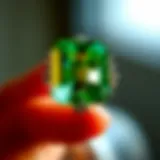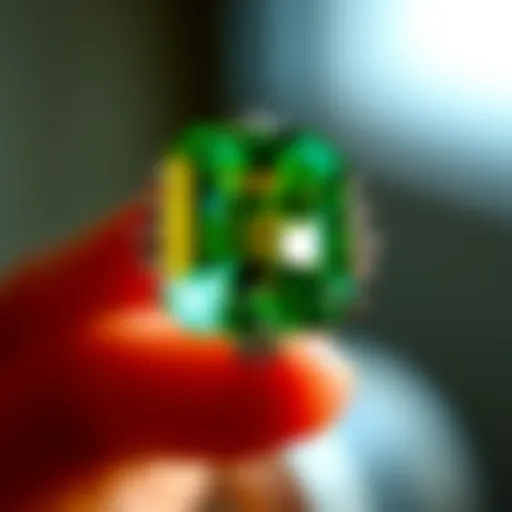Determining the Authenticity of Diamonds: A Comprehensive Guide
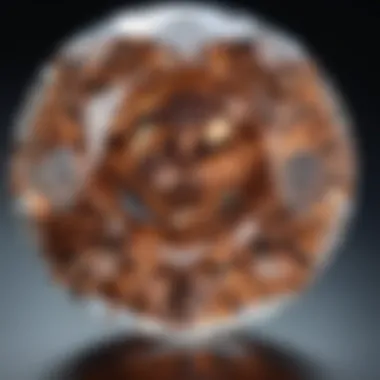

Intro
The allure of diamonds is undeniable. These gemstones have fascinated humanity for centuries, valued not only for their beauty but also for their perceived rarity and strength. Understanding the intricacies of diamonds goes beyond appreciation; it requires knowledge about their authenticity. As diamond simulants—materials that imitate the appearance of diamonds—become more sophisticated, distinguishing between a genuine diamond and a fake can be challenging for laypersons and enthusiasts alike. This guide aims to provide comprehensive insights into verifying diamond authenticity, encompassing visual inspections, physical tests, and advanced scientific evaluations.
Gemstone Overview
Definition and Characteristics
Diamonds are a type of carbon crystal, renowned for their exceptional hardness and brilliance. They form under immense pressure and high temperatures deep within the Earth’s mantle. The unique structure of diamond crystals results in their renowned optical properties, including high refractive index and scintillation. Each diamond is graded based on the four Cs: Carat, Cut, Clarity, and Color. These characteristics define the diamond's overall value and desirability.
Classification of Gemstones
Gemstones are classified based on various criteria, including their mineral composition, origin, and appearance. Diamonds fall under the category of precious gemstones, which also includes rubies, sapphires, and emeralds. In contrast to semi-precious stones, precious gemstones are typically rarer and more valuable. This classification affects both the market and consumer perception.
While diamonds are the hardest known natural material, they can still chip or fracture under extreme conditions. Understanding their classification helps consumers navigate the complex gemstone market.
Properties of Gemstones
Physical Properties
Diamonds possess several distinctive physical properties. These include their exceptional hardness, measured as 10 on the Mohs scale. This hardness means diamonds can scratch almost all other materials. Additionally, their ability to disperse light results in stunning brilliance and fire. Diamonds also exhibit unique optical phenomena such as fluorescence, where they emit visible light when exposed to ultraviolet rays.
Chemical Properties
Chemically, diamonds are composed of pure carbon atoms arranged in a crystal lattice structure. This structure contributes to their hardness and thermal conductivity. They are stable at room temperature but can graphitize at high temperatures if exposed to oxygen. Knowledge of these properties helps collectors and enthusiasts assess the legitimacy of diamonds by understanding how they can behave under certain conditions.
To successfully distinguish a genuine diamond from simulants, one must understand the physical and chemical properties that define the nature of a diamond.
Incidents of misrepresented gems can lead to financial loss, making it imperative for buyers to educate themselves on the essential aspects of diamond authenticity. With the evolving landscape of gemstone simulants, this competence not only adds to one’s appreciation but serves as a necessary skillset in the gemstone market.
Understanding Diamonds
Diamonds are more than just beautiful gemstones; they are valued for their unique characteristics and compositional elements. Understanding diamonds serves as the foundation for anyone looking to identify their authenticity. Knowledge about diamonds assists buyers in making informed decisions that can significantly impact their investment and satisfaction. It also helps in appreciating the intricate science behind these gemstones, providing context to the various evaluation methods discussed later.
Diamond Composition
Diamonds consist primarily of carbon atoms structured in a tetrahedral formation. This unique crystal lattice contributes to their renowned hardness, rated as a 10 on the Mohs scale. The purity and arrangement of these carbon atoms largely influence the diamond's overall quality and value. Variations in this composition can result in inclusions or impurities, which play a crucial role in determining clarity and, consequently, authenticity.
Types of Diamonds
Natural Diamonds
Natural diamonds are formed deep within the Earth over millions of years through high-pressure and high-temperature conditions. They are often more highly valued due to their rarity and the natural processes involved in their creation. One key characteristic of natural diamonds is their unique inclusions, which can be used as identifying markers. These inclusions, often perceived as flaws, contribute to the diamond's character and tell a story of its formation. Natural diamonds are a beneficial choice for collectors and investors looking for unique pieces with inherent value.
Synthetic Diamonds
Synthetic diamonds, created in laboratories, have the same physical and chemical properties as natural diamonds. The two common methods for producing synthetic diamonds are High Pressure High Temperature (HPHT) and Chemical Vapor Deposition (CVD). Their key characteristic is their ability to be produced in a controlled environment, making them more accessible and often less expensive than natural diamonds. Synthetic diamonds pose both advantages and disadvantages, as their growing presence in the market raises questions about value and authenticity. They are popular among consumers seeking ethically sourced options, yet their availability makes it more critical to identify them accurately.
Simulants
Simulants are materials that mimic the appearance of diamonds but lack the same chemical structure or properties. For example, cubic zirconia and moissanite are commonly used as diamond alternatives. Their primary advantage lies in their affordability, allowing consumers to achieve a similar aesthetic without significant investment. However, simulants can often deceive unwary buyers, making discernment crucial. Understanding simulants helps buyers differentiate between genuine diamonds and lesser imitations, which is vital for safeguarding their purchases.
The Importance of Authenticity
Authenticity is paramount in the diamond market. Owning a genuine diamond not only represents a financial investment but also signifies cultural and emotional value. Buyers want to ensure that they are paying for what they believe to be real, particularly given the significant sums involved. Furthermore, an authentic diamond often comes with a story, enhancing its sentimental value. Understanding authenticity ensures buyers are well-equipped to protect their investments, thereby fostering confidence in their purchases. Keeping informed about the nuances of diamonds can significantly improve the quality of one’s decisions in this intricate market.
Physical Characteristics of Diamonds
Understanding the physical characteristics of diamonds is vital in determining their authenticity. Each diamond has unique aspects that contribute to its identity, value, and quality. By grasping these characteristics, you can make informed decisions when purchasing diamonds, ensuring that what you buy is genuine and worth your investment.
The four primary physical characteristics—clarity, cut quality, color grading, and carat weight—serve as benchmarks in assessing a diamond’s value and authenticity. These elements are not merely aesthetic; they also influence the stone's brilliance and overall appeal. Each category plays a crucial role in differentiating a real diamond from simulants.
Clarity and Inclusions
Clarity refers to the presence of internal or external flaws in a diamond. The fewer the blemishes and inclusions, the higher the clarity, thus enhancing the diamond’s overall value. Inclusions are natural imperfections that occur during a diamond's formation. A diamond with many noticeable inclusions is less attractive and, therefore, less authentic.
To evaluate clarity:
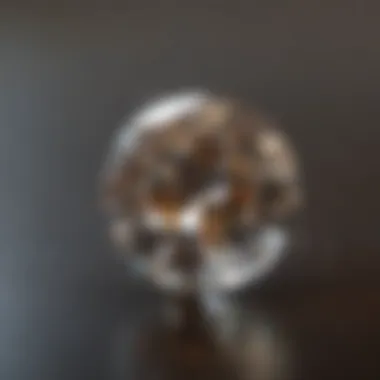

- Use a loupe or microscope to examine the diamond. This tool can reveal tiny marks and inclusions that are invisible to the naked eye.
- Familiarize yourself with clarity grading scales, which typically classify diamonds as Flawless, Internally Flawless, Very Slightly Included, Slightly Included, and Included.
Focusing on clarity provides insight into the quality of the diamond, enriching your understanding of its authenticity.
Cut Quality
The term cut quality encompasses the diamond’s proportions, symmetry, and polish. A diamond cut with precision captures light beautifully, resulting in superior brilliance and fire. Cuts are generally classified as Ideal, Excellent, Very Good, Good, Fair, and Poor.
To assess cut quality:
- Observe the diamond under different lighting conditions to see how it sparkles and reflects light.
- Pay attention to the proportions of the diamond, such as table size and depth percentage. Proper proportions enhance light performance.
A well-cut diamond stands out in both aesthetics and authenticity, differentiating itself from less skillfully cut stones.
Color Grading
Color grading involves assessing the hue of a diamond. The ideal diamond is colorless; however, most diamonds exhibit some degree of color, typically graded from D (colorless) to Z (light yellow or brown). The color can significantly affect a diamond's value and beauty.
To evaluate color:
- Look at the diamond stone face down against a white background. This helps accurately assess the color.
- Compare the diamond to a set of master stones with known color grades for more precise evaluation.
Understanding color grading not only reveals the diamond's quality but also helps you discern between natural ones and potentially altered stones.
Carat Weight
Carat weight measures how much a diamond weighs. One carat is equivalent to 200 milligrams. Generally, larger diamonds command higher prices, but weight alone does not determine value. Two diamonds of equal carat weight can differ significantly in value based on clarity, cut, and color.
To gauge carat weight:
- Consider the overall measurements; a diamond's dimensions may make it appear larger or smaller than its carat weight suggests.
- Be aware of how different shapes affect perceived size. For instance, a round diamond might look smaller than an emerald-cut diamond of the same carat weight due to differences in surface area.
Knowledge of carat weight is key to ensuring that you assess the diamond appropriately relative to its other characteristics.
"The value of a diamond is not solely dictated by size; it is a multifaceted assessment of its inherent characteristics."
Visual Inspection Techniques
Visual inspection techniques are crucial when determining the authenticity of diamonds. These methods provide an initial assessment that can often save time and prevent further costly testing. Each technique emphasizes observable elements that reflect the diamond's unique characteristics, allowing individuals to identify potential fakes efficiently.
The process begins with careful observation of the diamond's surface and internal features. The primary benefits of visual inspection include its simplicity and the immediate results it yields. By employing basic tools, anyone can conduct these evaluations at home or in a professional setting. However, a critical consideration is the experience and knowledge of the examiner. A well-trained eye can distinguish nuanced details that a novice might overlook.
The techniques discussed here are the foundation for a more thorough examination and often point towards further testing when irregularities are detected. The more familiar one becomes with these visual cues, the more adept they will be at spotting authentic diamonds.
The Loupe Test
The loupe test is a fundamental method for assessing diamond authenticity. A jeweler's loupe is a small magnifying lens, typically around 10x magnification, that allows for close examination of a gemstone’s facets and inclusions. When performing a loupe test, the user should look closely for imperfections known as inclusions. Natural diamonds often display unique inclusions that can confirm their authenticity.
In addition to identifying inclusions, the loupe test can reveal the quality of the cut, proving whether the diamond has been well crafted. Poor craftsmanship may indicate a synthetic diamond. Observing the edges can also help; a well-cut diamond displays sharp, clean lines. On the other hand, synthetic stones may show rounded edges.
Refraction and Sparkle
Refraction and sparkle, or brilliance, are vital characteristics of genuine diamonds. When light enters a diamond, it refracts in a unique way due to its high refractive index. Observing how light interacts with the diamond can be telling. Authentic diamonds exhibit a particular sparkle due to their cutting style and precision.
To assess this, hold the diamond under a light source and observe both the reflections from the surface and the sparkle it produces. Genuine diamonds should reflect a combination of white light and colored light. If the stone lacks the dazzling brilliance typical of diamonds, it may be a simulant. Furthermore, it is essential to note how the diamond behaves in different lighting conditions, as genuine diamonds should maintain their sparkle.
A diamond's unique play of light is a signature feature that can be observed through careful visual inspection.
By mastering these techniques, gem enthusiasts, collectors, and designers can enhance their ability to identify authentic diamonds. Understanding the nuances of a diamond's quality is instrumental in making informed purchases.
Common Tests for Authenticity
In the realm of gemology, establishing the authenticity of diamonds is paramount. Not only does it protect a buyer's investment, but it also enhances the understanding of gemstones. Common tests offer accessible and practical methods for individuals to assess whether they hold a real diamond or a simulant. These tests can often be conducted at home or with minimal equipment. They help to build confidence and knowledge among gemstone enthusiasts, collectors, and those involved in jewelry design. While these tests do not substitute professional evaluations, they serve as an essential preliminary step in diamond verification.
Water Test
The water test is a simple yet effective method to differentiate diamonds from some simulants. It takes advantage of diamonds' unique density. To perform this test, you need a clear glass of water.
- Fill a glass with water.
- Gently drop the stone into the water.


A genuine diamond will sink to the bottom due to its high density. In contrast, many simulants, including cubic zirconia, will either float or rest just beneath the surface. While this test has some limitations, it is a quick way to assess authenticity.
Fog Test
The fog test provides another practical way to gauge diamond authenticity based on thermal conductivity. This test evaluates how quickly a diamond disperses heat.
- Breathe on the diamond gently.
- Observe how the fog dissipates.
If the diamond is real, the fog will clear up almost immediately. This is due to the stone's ability to conduct heat away rapidly. Conversely, simulants retain the fog for a longer period. This method is straightforward and gives instant results, making it an appealing choice for enthusiasts.
Heat Test
The heat test is a useful means to evaluate the heat resistance of a diamond compared to simulants. Real diamonds can withstand a significant amount of heat without altering their structure. The test measures the stone’s reaction to sudden temperature changes.
- Heat a piece of metal, such as a needle, until it's hot.
- Touch the tip of the needle to the surface of the diamond.
A genuine diamond will not be damaged or stained. In contrast, many simulants may show discoloration or even damage under heat. However, care should be taken as the heat could potentially harm the diamond's setting.
These tests are introductory tools for identifying diamonds. They should not replace professional evaluations from accredited gemologists.
Advanced Testing Methods
Advanced testing methods are crucial in the quest to determine the authenticity of diamonds. This segment focuses on professional techniques that can provide reliable results beyond basic visual or physical tests. Utilizing advanced methods ensures that buyers can make informed decisions when investing in diamonds. These methods offer precision and are generally conducted by trained professionals or utilizing specialized equipment. In a market flooded with simulants and synthetics, these approaches reduce the risk of deception significantly.
Gemological Instruments
Gemological instruments play a significant role in advanced testing methods. The technology and techniques involved allow for deeper inspection of diamonds.
Refractive Index Measurement
Refractive index measurement is a fundamental technique employed in gemology. It focuses on determining how much light bends when entering a diamond. The refractive index for diamonds is approximately 2.42, which is noticeably higher than that of many simulants.
This technique provides a key characteristic: the ability to differentiate genuine diamonds from their fakes quickly. By measuring the refractive index through professional equipment, gemologists can confirm a stone's authenticity.
One unique feature of refractive index measurement is its non-destructive nature. There are no physical alterations to the diamond, preserving its integrity while testing. However, it requires specialized equipment, which may limit accessibility for casual buyers.
Advantages of this method include high reliability and accuracy in identifying diamonds, while the main disadvantage is the need for professional training and equipment.
Spectroscopy
Spectroscopy is another sophisticated method used to analyze the properties of diamonds. This technique measures how light interacts with the diamond, helping to identify its composition and structure.
The key characteristic of spectroscopy is its capacity to detect specific spectral lines unique to diamonds. This makes it an effective choice for distinguishing between real diamonds and simulants. By analyzing the light absorption and emission patterns, gemologists can ascertain valuable information about the diamond’s authenticity.
A unique feature of spectroscopy incorporates both visible and infrared light, offering a comprehensive analysis that few other methods provide. It is advantageous in identifying synthetic diamonds as well, which often have different spectral characteristics compared to natural diamonds.
Yet, the complexity of interpreting the spectroscopic data means it is typically reserved for professionals. The initial setup can be costly, but the depth of information it provides can greatly enhance a buyer's confidence in their purchase.
Professional Appraisals
Professional appraisals involve trained gemologists who possess the expertise needed to evaluate a diamond's authenticity thoroughly. This process is more than just verifying a stone; it includes detailed assessments of quality, cut, clarity, and overall value.
Such appraisals commonly result in a certification, which is essential for buyers. Trusting a credible expert to provide this service ensures that buyers can navigate the complex diamond market with confidence, minimizing the probability of counterfeit purchases.
Identifying Diamond Simulants
Identifying diamond simulants is crucial in the realm of gemology. As the market for diamonds grows, both in natural and synthetic forms, consumers must distinguish between authentic diamonds and imitations to make informed purchasing decisions. Simulants can sometimes exhibit similar physical properties, making it difficult for the untrained eye to determine authenticity. Understanding the differences is key when evaluating diamonds.
Moissanite vs. Diamond
Moissanite is often touted as the closest diamond simulant available. While both stones share a similar appearance, there are distinct differences. Moissanite displays a higher refractive index than diamonds, resulting in a noticeable brilliance. Additionally, it has a unique light dispersion that can create a colorful sparkle.
- Price Point: Moissanite is generally more affordable than natural diamonds. This lower cost makes it popular among budget-conscious consumers.
- Hardness: Moissanite scores 9.25 on the Mohs scale, making it very durable, yet still somewhat less than diamonds' perfect score of 10.
When evaluating stones, pay attention to the certificate authenticity. If it indicates moissanite, the features may differ significantly from diamonds, despite their visual similarities.
Cubic Zirconia Features
Cubic Zirconia (CZ) is another common diamond simulant. It has gained popularity due to its low price and decent resemblance to diamonds. However, certain characteristics can help identify CZ.
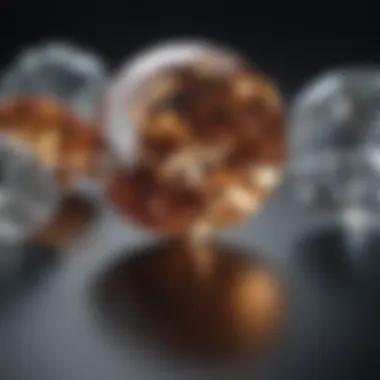

- Weight: CZ is denser than diamonds. A cubic zirconia stone will weigh more than a diamond of the same size.
- Clarity and Cut: CZ is usually flawless. In contrast, diamonds possess inclusions that are often considered desirable.
- Color: While colorless CZ exists, it can often be produced in various colors, lacking the subtle hues that natural diamonds may exhibit.
Awareness of these features can help consumers avoid being misled by may imitations.
Other Synthetic Diamonds
Other synthetic diamonds can also pose a challenge in identification. While these lab-grown diamonds share the same chemical composition as natural diamonds, their methods of creation differ.
- Lab-grown Diamonds: These are produced under controlled conditions, mimicking natural processes. They are genuinely diamonds, not simulants, but they may come with a lower price tag.
- Color Variations: Many synthetic diamonds have unique color zoning, which can be detected through advanced imaging techniques. This can distinguish them from natural stones that typically exhibit uniform color.
In summary, being able to identify diamond simulants is essential for anyone involved in the diamond market. Knowledge of the features and characteristics of stones such as moissanite, cubic zirconia, and other synthetic diamonds can prevent costly mistakes. Utilize reliable resources and professional guidance when making diamond purchases.
The Role of Certificates
In the realm of diamond purchasing, certificates carry significant weight. They serve as authoritative documents that verify the characteristics and authenticity of a diamond. A certificate can differentiate between a precious stone and a mere simulant. For buyers, understanding the role of certificates could mean the difference between investing wisely and suffering financial loss due to ill-informed decisions.
Certificates are generated by reputable certification bodies that conduct comprehensive evaluations of diamonds using a range of scientific and gemological techniques. These documents detail essential attributes, including cut, color, clarity, and carat weight. Their existence serves not only as proof of a diamond's origin but also as a selling point that may enhance its market value.
Key Elements and Benefits of Certificates
- Authenticity Verification: Certificates confirm whether a diamond is genuine. They provide adequate assurance, especially for high-value purchases.
- Details on Quality: Certifications offer a clear understanding of a diamond's features through grading scales, allowing consumers to make informed choices.
- Comparison Tool: Buyers can compare multiple stones with the help of certifications. Each report outlines different characteristics, making selection easier.
- Market Confidence: Possessing a certified diamond gives added confidence to both buyers and sellers, as the certification is a recognized standard in gemology.
However, it is essential to recognize that not all certificates are of equal value. The credibility of the certification body is a critical factor that buyers must consider.
Credible Certification Bodies
When discussing diamond certificates, a handful of reputable certification organizations stand out in terms of their global recognition and rigorous standards. These include the Gemological Institute of America (GIA), the International Gemological Institute (IGI), and the American Gem Society (AGS).
Gemological Institute of America (GIA)
The GIA is perhaps the most well-known and respected of all certification bodies. It offers detailed evaluations that adhere to strict grading criteria. GIA diamonds are typically considered more valuable due to their trustworthy grading.
International Gemological Institute (IGI)
The IGI is recognized for its wide reach, conducting evaluations globally. Though it is considered slightly less stringent than GIA, it still provides reliable certifications with a focus on consumer education.
American Gem Society (AGS)
AGS specializes in grading diamond cut quality, placing importance on craftsmanship. Their certifications reflect this with a comprehensive analysis of each diamond's cut performance.
Other Notable Bodies
Other credible organizations include the European Gemological Laboratory (EGL) and the Gem Certification & Assurance Lab (GCAL). Both have their strengths, but buyers should remain aware of variations in grading practices.
Understanding Diamond Reports
A diamond report is the core of the certification process. Typically, they include several components that are essential for making an informed buying decision.
Essential Features of Diamond Reports
- 4 Cs: The report details the diamond's cut, color, clarity, and carat weight. This system helps buyers understand the quality of their diamond relative to others in the market.
- Identification Details: Each report will include unique identifiers or laser inscriptions that match the report to the specific diamond.
- Grading Scale: The grading scale used (like GIA, AGS, or others) is fundamental to understanding the quality assurance provided by the report. Each organization may have slightly different grading methods.
- Photographs: Many reports include photographs or diagrams that help visualize inclusions and other characteristics. This visual aid enhances comprehension and allows for easier comparison.
- Summary Box: Often, reports include a summary box that condenses the most crucial information, making it user-friendly.
The clarity of the diamond report can significantly impact consumer trust. A well-drafted report provides clear, factual, and unbiased information, thus enriching the purchasing experience.
In summary, understanding certificates and reports is a vital aspect of determining diamond authenticity. Consumers are encouraged to think critically about the information these documents hold and use them as tools to enhance their diamond purchasing knowledge.
Ending: The Importance of Due Diligence
In the realm of diamond purchasing, due diligence is not just a luxury; it is a necessity. The journey of acquiring a diamond often comes with substantial financial implications, alongside emotional value. Therefore, understanding the factors that determine authenticity is vital. Only through diligent investigation can buyers ensure they are investing in genuine gems rather than simulants or inferior products.
Buyers must adopt a multifaceted approach, utilizing both scientific methods and hands-on tests. Familiarizing oneself with certification from credible bodies, such as the Gemological Institute of America (GIA) or the American Gem Society (AGS), forms a critical component of verification. Certificates often provide essential details about the diamond's characteristics—shape, clarity, color, and cut—which guide the decision-making process. Each of these aspects can significantly influence both the beauty and the value of a diamond.
"Knowledge is power. Understanding the nuances of diamond certification empowers consumers to make informed decisions and ensures they do not fall prey to fraudulent sellers."
Protecting Your Investment
Investing in diamonds, especially in today’s jewelry market, requires careful consideration. In light of this, protecting your investment is paramount. Authentic diamonds retain their value; however, fake stones can lead to financial loss.
When you choose to purchase a diamond, looking for a reputable jeweler is essential. Verify the authenticity of diamonds through certificates, and aim for transparency in terms of pricing and quality. Furthermore, considering options for insuring your diamond can mitigate risks associated with theft or loss. An appraisal not only serves as validation of authenticity but can also prove invaluable in case of unfortunate events.
Enhancing Your Knowledge Base
The process of learning about diamonds is ongoing and impactful. By enhancing your knowledge base, you empower yourself to navigate the complexities of the gemstone market confidently. Understanding the distinctions between natural diamonds and their synthetic counterparts aids in making informed choices.
Taking the time to read educational resources, participate in workshops, or connect with gemology experts can significantly boost your expertise. This proactive approach not only fosters a richer appreciation for diamonds but also sharpens your negotiation skills. Engaging with communities on platforms like Reddit or relevant Facebook groups can also serve as valuable avenues for exchanging insights and best practices in diamond procurement.


